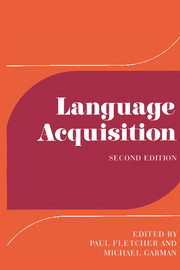Book contents
- Frontmatter
- Contents
- Contributors
- Preface
- Part I Contexts and determinants
- Part II The development of linguistic systems: phonology
- Part III The development of linguistic systems: grammar
- Introduction
- 13 Early vocabulary
- 14 Early syntax
- 15 Assessing morphological development
- 16 Personal pronouns
- 17 Tense and aspect
- 18 Modality
- 19 Deixis
- 20 A crosslinguistic perspective: morphology and syntax
- Part IV Later language development
- Notes to chapters
- Bibliography and citation index
- General index
- Titles in the series
19 - Deixis
Published online by Cambridge University Press: 05 June 2012
- Frontmatter
- Contents
- Contributors
- Preface
- Part I Contexts and determinants
- Part II The development of linguistic systems: phonology
- Part III The development of linguistic systems: grammar
- Introduction
- 13 Early vocabulary
- 14 Early syntax
- 15 Assessing morphological development
- 16 Personal pronouns
- 17 Tense and aspect
- 18 Modality
- 19 Deixis
- 20 A crosslinguistic perspective: morphology and syntax
- Part IV Later language development
- Notes to chapters
- Bibliography and citation index
- General index
- Titles in the series
Summary
Introduction
What do such diverse expressions as demonstratives, pronouns, adverbs of place, verbs of motion such as come and go, definite articles, tenses, etc. have in common? They are all held to be deictic expressions. Deixis is the Greek word for indicating or pointing. It has been taken over as a technical term in linguistics to refer to those terms or expressions which serve this linguistic function. That is, they are all expressions which serve to direct the hearer's attention to spatial or temporal aspects of the situation of utterance which are often critical for its appropriate interpretation. They do this in a way which is particularly interesting, since they serve as a meeting point for syntactic, semantic and pragmatic aspects of language. This is because they are, to use G. Stern's (1964) term, contingent expressions. By this is meant that, to interpret them, the interpreter needs not only context-independent semantic information but also information which is contingent on an actual (or construed) context. They are used to direct the attention of the hearer of a communication toward some object or event. The aspect of the situation/speech event which is critical in this regard is, typically, information about the speaker, but in any case this information must be such as to enable decisions to be made about person and/or place in relation to the utterance.
- Type
- Chapter
- Information
- Language AcquisitionStudies in First Language Development, pp. 401 - 428Publisher: Cambridge University PressPrint publication year: 1986
- 16
- Cited by



